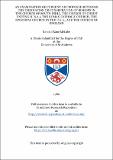Files in this item
An examination of current or proposed rites for the ordination or consecration of bishops in the Church of South India, the Church of Christ Uniting (U.S.A.), the Roman Catholic Church, the Episcopal Church in the U.S.A., and the Church of England
Item metadata
| dc.contributor.advisor | Keeling, J. M | |
| dc.contributor.author | McCabe, Kendall Kane | |
| dc.coverage.spatial | ii, 430 p. | en_US |
| dc.date.accessioned | 2018-05-29T09:08:38Z | |
| dc.date.available | 2018-05-29T09:08:38Z | |
| dc.date.issued | 1980-01 | |
| dc.identifier.uri | https://hdl.handle.net/10023/13581 | |
| dc.description.abstract | The rites for the consecration (ordination) of bishops in the churches listed in the title are examined against the background of the development of episcopal functions through the centuries, the controversies about the nature of the episcopate as a third order of ministry, and recent statements about the nature of episcopal ministry. Four issues are isolated as being paramount for understanding the present position of the episcopate in the West: (1) the development of the doctrine of apostolic succession; (2) the theological controversies concerning the relation of the episcopate to the presbyterate; (3) in Roman Catholicism, the papal claims to an immediate jurisdiction superior to the bishops' ; and (4) in Anglicanism, with major consequence for all subsequent ecumenical discussion, the effect of the Oxford Movement with its insistence upon the importance of the historic episcopate. Three sets of contemporary documents are analysed to see how they have dealt with the four issues in light of the needs of the contemporary Church: (1) from the documents of Vatican II, the second chapter of Lumen Gentium and the pastoral decree, Christus Dominus; (2) from the Faith and Order Commission of the World Council of Churches, the agreed statement drafted at Accra in 1974, The Ordained Ministry in Ecumenical Perspective; and (3) the preparatory papers and subsequent reports of the 1978 Lambeth Conference. The five rites are then examined to see how they reflect both the historical issues and the positions set forth in the recent documents. The examination of the rites is divided into two parts. First, the rites themselves are reproduced in full as head-notes with accompanying historical and liturgical annotations. Then, at the end of each rite, there is an essay discussing how the issues raised in the first three chapters have been treated and the Implications for understanding the issues in terms of text and rubric, A final essay deals with the lections appointed to be read in the services, comparing and contrasting the choices made, discussing the implications of those choices, and considering how they might be used as the basis for the ordination sermon. The final chapter summarizes the liturgical and theological approaches represented by the rites and discusses briefly how, on the basis of those rites, the ministry of bishops is to be understood in the churches which employ them. | en_US |
| dc.language.iso | en | en_US |
| dc.publisher | University of St Andrews | |
| dc.subject.lcc | BV830.E7M3 | en |
| dc.subject.lcsh | Ordination--Church of South India | en |
| dc.subject.lcsh | Ordination (Liturgy) | en |
| dc.subject.lcsh | Church of England--Clergy | en |
| dc.subject.lcsh | Episcopal Church in the United States | en |
| dc.title | An examination of current or proposed rites for the ordination or consecration of bishops in the Church of South India, the Church of Christ Uniting (U.S.A.), the Roman Catholic Church, the Episcopal Church in the U.S.A., and the Church of England | en_US |
| dc.type | Thesis | en_US |
| dc.type.qualificationlevel | Doctoral | en_US |
| dc.type.qualificationname | PhD Doctor of Philosophy | en_US |
| dc.publisher.institution | The University of St Andrews | en_US |
This item appears in the following Collection(s)
Items in the St Andrews Research Repository are protected by copyright, with all rights reserved, unless otherwise indicated.

